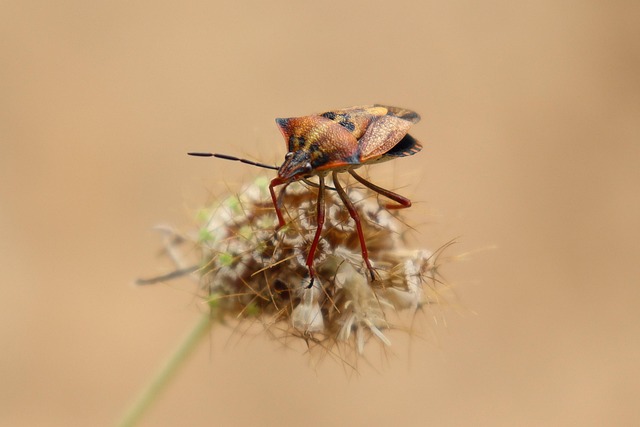Pillbugs, though unrelated to armadillos, thrive in damp, shady areas both indoors and outdoors. To adopt an eco-friendly approach, maintain a clean environment, seal gaps, and incorporate natural repellents like peppermint or neem oil. Outdoors, plant lavender, mint, and basil to deter pillbugs and attract beneficial insects. Effective eco-friendly methods include sanitation, introducing ladybugs or predacious mites, and using essential oils like neem as repellents and insecticides. Strategically placing natural barriers along foundation lines helps manage pillbug invasions while promoting energy efficiency.
Pillbugs, also known as armadillos, can cause significant damage to indoor and outdoor spaces. This article explores effective methods for controlling pillbug infestations, focusing on eco-friendly solutions. We begin by understanding these pests and their preferred habitats, followed by natural prevention strategies. Next, discover natural control methods and powerful outdoor management techniques that offer lasting results. Explore these eco-friendly pillbug solutions to reclaim your living spaces effectively and responsibly.
Understanding Pillbugs and Their Habitat
Pillbugs, scientifically known as Armadillium vulgare, are small, wingless insects that belong to the armadillo family. Despite their name, they are not related to true armadillos and are instead distant cousins. These creatures are commonly found both indoors and outdoors in various habitats. Understanding where pillbugs thrive is crucial when implementing eco-friendly pillbug solutions.
In terms of indoor environments, pillbugs prefer dark, damp spaces with limited airflow. They can be found under rugs, in crawl spaces, behind baseboards, or even within cracks in walls. Outdoors, they inhabit moist, shady areas like garden beds, compost piles, and leaf litter. Recognizing these preferred habitats is the first step in effectively controlling pillbug populations through natural means.
Eco-Friendly Prevention Strategies
To adopt an eco-friendly approach to controlling pillbugs, start by taking preventive measures both indoors and outdoors. One effective strategy is to maintain a clean and clutter-free environment as pillbugs are attracted to decaying organic matter and tight spaces for hiding. Regularly cleaning floors, especially in corners and under furniture, can reduce their habitat. Additionally, seal any gaps or cracks in walls, doors, and windows to prevent these tiny insects from entering your space.
Using natural repellents like peppermint oil, neem oil, or garlic extract is another promising eco-friendly solution. These substances not only deter pillbugs but are also safe for pets and humans. Incorporating these repellents into your cleaning routine can help keep pillbugs at bay. Furthermore, promoting a healthy garden ecosystem outdoors by planting herbs like lavender, mint, and basil can act as natural barriers against pillbug infestations while attracting beneficial insects that feed on them.
Natural Control Methods
Pillbugs, also known as carpet beetles, can be a persistent nuisance both indoors and outdoors. Fortunately, there are several effective and eco-friendly pillbug solution methods that offer natural control. One approach is to maintain excellent sanitation, especially in areas prone to moisture buildup, as these conditions favor pillbug proliferation. Regularly cleaning and drying carpets, mops, and floor cushions can significantly reduce their population.
Another natural method involves introducing beneficial insects such as ladybugs or predacious mites that specifically target pillbugs. These insects feed on the beetles, helping to control their numbers in a biological and eco-friendly manner. Additionally, using plant essential oils like neem oil or peppermint oil has proven effective. Spraying these oils directly onto affected areas can act as a repellant and natural insecticide, disrupting the pillbug’s life cycle without harming the environment.
Effective Outdoor Management Techniques
Pillbugs, also known as cockroaches, are a common outdoor pest that can quickly invade homes and gardens. To effectively manage these pesky critters outdoors, consider implementing eco-friendly solutions. One powerful method is to maintain a healthy garden ecosystem by promoting beneficial insects like ladybugs and spiders, which naturally feed on pillbugs. Additionally, regular watering and mowing can disrupt their breeding grounds, as adult pillbugs and their nymphs are more visible in dry, tall grass.
Another sustainable approach involves using natural repellents such as neem oil or diatomaceous earth. These organic compounds effectively deter pillbugs without causing harm to the environment or other beneficial insects. Strategically placing these substances along foundation lines, in crawl spaces, and around entry points can create a barrier against pillbug invasions. Moreover, sealing cracks and gaps in exterior walls and doors not only prevents their access but also promotes energy efficiency by keeping pests out and your home cool.
Controlling pillbug infestations both indoors and outdoors requires a multi-pronged approach. By understanding these pests’ habits and habitats, we can implement effective strategies that range from eco-friendly prevention to natural control methods. For outdoor management, specific techniques target their breeding grounds, disrupting the lifecycle of pillbugs naturally. Adopting these integrated pest management (IPM) practices not only effectively eliminates pillbug populations but also promotes a safer, more sustainable environment, ensuring that both your home and garden are free from these persistent invaders while fostering a harmonious coexistence with nature. For those seeking eco-friendly pillbug solutions, the methods outlined in this article provide a comprehensive guide to achieve just that.
